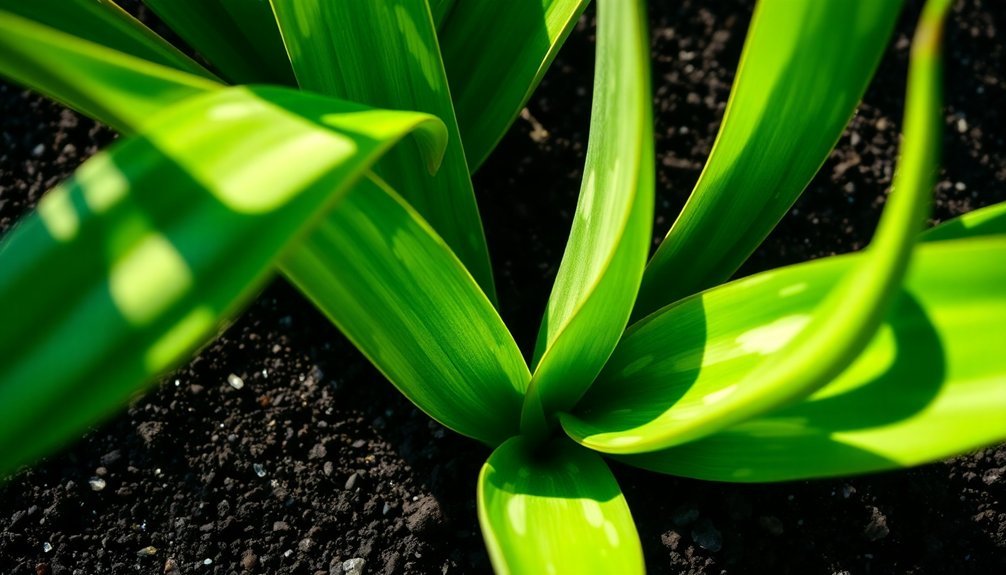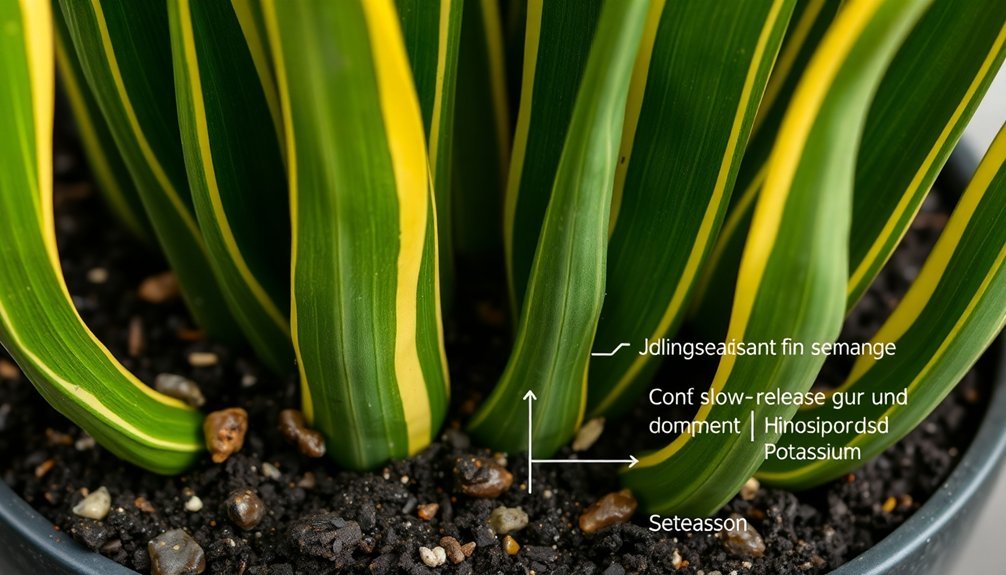Your snake plant needs three key nutrients to thrive: nitrogen for lush foliage, phosphorus for strong roots, and potassium for stress resistance. You'll want to maintain a balanced NPK ratio (like 10-15-10) in slightly acidic soil with a pH between 6.0 and 7.5 for ideal nutrient absorption. Adding organic compost enriches the soil and promotes healthy growth. Understanding the role of micronutrients can take your plant care to the next level.
Essential Macronutrients for Snake Plant Development

When it comes to nurturing a healthy snake plant, understanding the essential macronutrients is critical for success. Your snake plant needs three primary nutrients: nitrogen (N), phosphorus (P), and potassium (K), collectively known as NPK. Each plays a significant role in your plant's development.
Nitrogen guarantees your plant maintains lush, green foliage, while phosphorus strengthens root systems and supports flower production. Potassium helps your plant manage water efficiently and build resistance to stress.
You'll want to provide these nutrients through regular fertilization, especially during the growing season in spring and summer. A balanced ratio of NPK, such as 10-15-10, delivers the perfect blend of macronutrients for healthy development.
Mineral Balance and Root System Health
Building on the foundation of proper NPK ratios, maintaining the right mineral balance in your snake plant's soil directly impacts its root system health.
A balanced mineral foundation in soil ensures your snake plant develops a strong, healthy root system for optimal growth and vitality.
When you provide the ideal pH range of 6.0 to 7.5, your plant can efficiently absorb essential nutrients like nitrogen, phosphorus, and potassium. Adding organic matter enhances both nutrient availability and soil drainage, creating favorable conditions for root development.
- You'll feel proud watching your snake plant thrive with strong, vibrant leaves thanks to proper nitrogen levels.
- You'll be amazed at how robust root systems develop when phosphorus is readily available.
- You'll gain confidence as your plant shows increased resilience against stress and disease with balanced potassium.
Monitor your soil's nutrient levels regularly and make adjustments when needed to prevent deficiencies that could compromise your plant's health.
Soil Ph Impact on Nutrient Absorption

Understanding soil pH levels is fundamental to your snake plant's nutrient absorption process. You'll want to maintain slightly acidic soil with a pH between 6.0 and 7.5 to enhance nutrient availability. When you stray from this range, you risk nutrient deficiencies or toxicities that can harm your plant.
| pH Level | Effect | Action Needed |
|---|---|---|
| Below 6.0 | Manganese/iron toxicity risk | Add lime |
| 6.0-6.5 | Ideal nutrient absorption | Monitor only |
| 6.5-7.0 | Balanced nutrition | Monitor only |
| 7.0-7.5 | Good nutrient availability | Monitor only |
| Above 7.5 | Essential nutrient lockout | Add organic matter |
To maintain proper pH, regularly test your soil and make adjustments using soil amendments when needed. Your snake plant's health depends on its ability to access essential nutrients, which is directly influenced by soil pH levels.
Organic Matter Requirements for Growth
You'll find that adding natural compost to your snake plant's soil creates an enriched environment that promotes robust root development and overall plant health.
Leaf mold, a type of organic matter created from decomposed leaves, can enhance your soil's structure while providing essential nutrients and beneficial microorganisms.
These organic enrichment methods work together to maintain ideal moisture levels and prevent soil compaction, letting your snake plant thrive in well-balanced growing conditions.
Natural Composting Benefits
While snake plants are known for their resilience, adding natural compost to their soil can greatly boost their growth potential and overall health.
Natural composting enriches the soil with organic matter, helping improve drainage and providing essential nutrients your plant needs. You'll notice enhanced soil conditions that support robust leaf development and stronger root systems, all while maintaining a sustainable approach to plant care.
- You'll feel proud watching your snake plant thrive with vibrant, sturdy leaves thanks to the perfect balance of nitrogen, phosphorus, and potassium from compost.
- You'll save money and reduce environmental impact by eliminating the need for synthetic fertilizers.
- You'll experience the satisfaction of creating a self-sustaining ecosystem where beneficial microbes support your plant's health.
The process maintains ideal pH levels between 6.0 and 7.5, creating the perfect environment for your snake plant to flourish.
Leaf Mold Enrichment Methods
Building on the benefits of natural composting, leaf mold offers another powerful organic enrichment method for your snake plant's soil.
You'll find that leaf mold markedly improves soil nutrients while creating well-draining conditions that help snake plants thrive.
To maximize leaf mold's benefits, mix it with perlite or coarse sand in your potting mixes. This combination enhances both moisture retention and proper drainage, striking the perfect balance your snake plant needs.
The organic matter gradually releases nutrients, preventing over-fertilization while promoting healthy root development. You'll notice improved soil fertility as beneficial microorganisms multiply in the slightly acidic environment.
The slow-release nature of leaf mold means you're providing consistent nourishment without the risk of nutrient overload, making it an ideal component for long-term snake plant health.
Micronutrient Roles in Leaf Formation

Since healthy snake plant leaves depend on proper nutrition, understanding the role of micronutrients in leaf formation is crucial.
Your snake plant relies on iron, manganese, and zinc to produce chlorophyll, giving leaves their vibrant green color.
Boron strengthens cell walls, preventing leaf curling, while copper guarantees efficient photosynthesis for peak leaf growth.
Molybdenum helps metabolize nitrogen, supporting robust foliage development.
Here's what you'll notice if your plant lacks these essential micronutrients:
- Yellowing leaves that signal reduced chlorophyll production
- Weak, curling leaves due to compromised cell structure
- Stunted growth that prevents your plant from reaching its full potential
Nutrient Deficiency Signs and Solutions
To maintain a thriving snake plant, you'll need to recognize and address nutrient deficiency symptoms quickly. When you notice yellow leaves and stunted growth, your plant's likely suffering from nitrogen deficiency, which you can correct with a balanced fertilizer.
Watch for poor root development and reduced flowering, as these indicate phosphorus deficiency, especially during growing season. Your snake plant might show potassium deficiency through browning leaf edges and weak structure.
Don't overlook soil quality and drainage, as they directly impact nutrient availability. Regular monitoring of plant health helps you spot these nutrient deficiency signs early. By adjusting your fertilization routine based on observed symptoms, you'll prevent deficiencies before they become severe.
Remember that each deficiency requires specific solutions, so tailor your approach to the symptoms you see.
Seasonal Nutrient Needs and Adjustments

While snake plants remain hardy throughout the year, their nutrient requirements fluctuate with the seasons.
During the active growing season in spring and summer, your plant needs a balanced fertilizer like Schultz 10-15-10 to prevent nutrient depletion.
You'll notice that light exposure directly affects how often you should fertilize your snake plant: every three months in bright light, twice yearly in medium light, and annually in low light conditions.
- Don't let your beloved snake plant suffer from yellowing leaves and stunted growth due to inadequate feeding!
- Watch your plant flourish as you provide the nutrients it needs at just the right time!
- Give your plant an extra boost by mixing organic matter and compost into the soil!
Monitor your plant's response and adjust fertilization if you spot crispy leaf edges, indicating over-feeding.
Frequently Asked Questions
What Is the Best Nutrient for Snake Plants?
You'll want a balanced fertilizer with 10% nitrogen, 15% phosphorus, and 10% potassium (like Schultz 10-15-10). These nutrients support leaf greenness, root development, and cellular functions in your snake plant.
How Do You Make a Snake Plant Thrive?
You'll help your snake plant thrive by using well-draining soil, providing indirect light, watering only when soil's completely dry, fertilizing every 3-6 months, and maintaining temperatures between 60-85°F degrees.
What Is the Best Soil Mix for Snake Plants?
You'll get the best results mixing equal parts cactus soil and regular potting soil, adding perlite and sand for drainage. This creates an ideal fast-draining environment that'll prevent root rot in snake plants.
How Do I Increase My Snake Plant Growth?
You'll boost your snake plant's growth by using well-draining soil, providing bright indirect light, fertilizing every 3 months, and watering thoroughly but infrequently. Monitor for stress signs and adjust care as needed.
In Summary
You'll find success with your snake plant by maintaining proper nutrient levels in well-draining soil. Focus on nitrogen for leaf growth, phosphorus for root development, and potassium for overall health. Keep the soil pH between 5.5-7.5, and don't forget trace minerals like magnesium and iron. Watch for yellowing leaves or stunted growth, adjusting nutrients seasonally. With balanced nutrition, your snake plant will thrive for years.





Leave a Reply